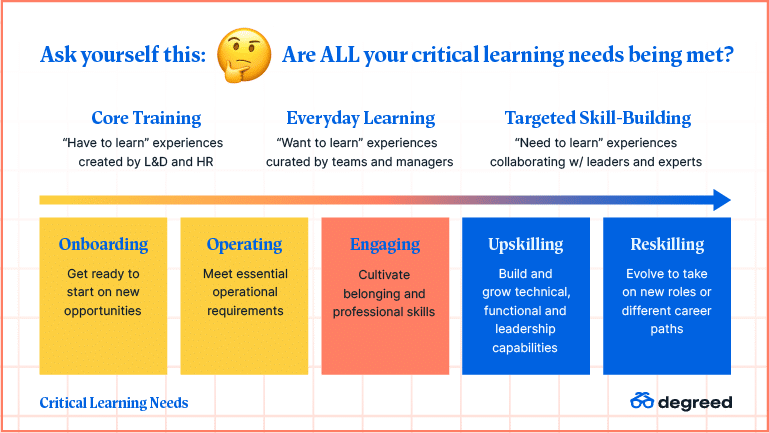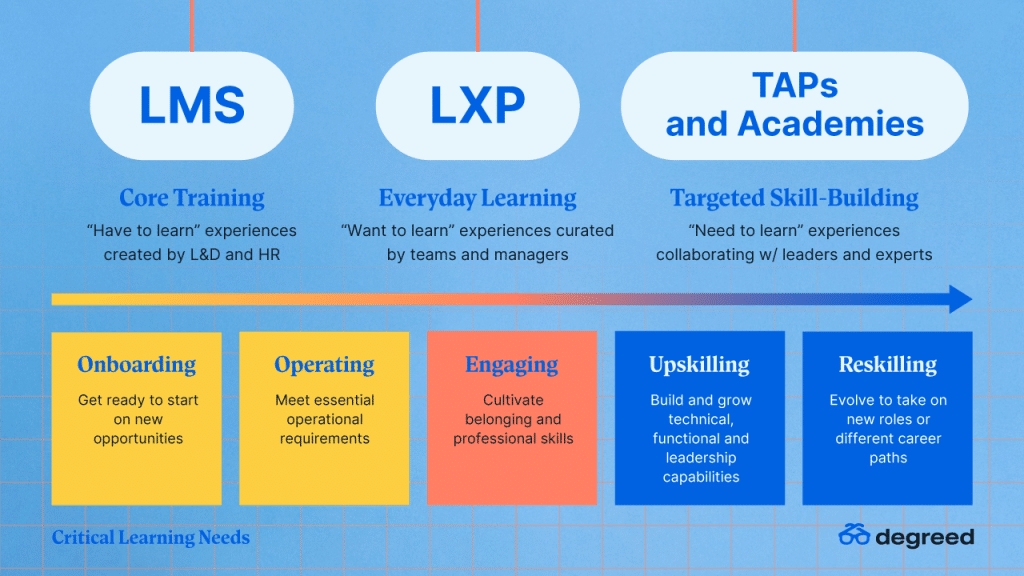The learning tech marketplace is a wild place that leaves L&D leaders with endless options and decisions to make. To make matters worse, the corporate learning solutions begin to blend together with their similar names, myriad terms, and definitions. In the end, it’s just a messy technology alphabet soup: LMS, LXP, TXP HRIS, and the list goes on.
Choosing corporate learning solutions is like reading a Choose Your Own Adventure book. But this adventure isn’t fun. It’s stressful.
To make the process easier, let’s get the lay of the land — take a look at a topographical map, if you will — and explore today’s learning tech marketplace, so you can choose the right tools to pursue your company’s upskilling adventure.
Step No. 1: Know your critical learning needs.
Forget the alphabet soup and focus on one thing: where you want to take your company on its learning journey. In other words, focus on your company’s critical learning needs.
To envision the broad spectrum of critical learning needs, think about your employees’ entire learning journey: what do your people need to learn from their first days until their last? To help you answer that question, the handy chart below identifies today’s most common critical learning needs: core training, everyday learning, and targeted skill-building.

Keep in mind that every company is unique. So of course you’ll want to identify and embrace your unique constellation of critical learning needs. And don’t discount learning needs that may fall outside of the purview of L&D. For example, if HR is in charge of your training, you still want to envision your entire company’s learning ecosystem to ensure it’s all interconnected and comprehensive.
Step No. 2: Find learning solutions based on your critical learning needs.
Now that you know your critical learning needs, focus on the corporate learning solutions that can help you meet those needs. You may be asking yourself: Is there a learning tech solution out there that magically fulfills all of these critical learning needs? Unfortunately, no. That technology doesn’t exist — yet. So for right now, if you have more than one critical need, you’ll most likely need more than one learning tech solution to get the job done.
In fact, for the past five years or so many large corporations have relied on the dynamic tag-team of an LMS for training and onboarding and LXP for everyday learning. These two together, until recently, accommodated most critical learning needs.
Now, with widening skill gaps — gaps exacerbated by the ridiculous speed of technology like Generative AI — companies desperately need another critical learning need to be filled: deep upskilling and reskilling. What solutions exist for this critical learning need? Well, that’s still a bit murky. Let’s look at the options emerging.

The image above aligns major corporate learning solutions with the critical learning needs they’re trying to meet. Don’t freak out about all that information; it looks complex, but it’s there to help.
You’ll notice that in that image, we’ve included four types of corporate learning solutions:
- Learning Management System (LMS)
- Learning Experience Platform (LXP)
- Tuition Assistance Program (TAP)
- Academies
Obviously, this list doesn’t include everything in the learning tech marketplace. But what you see covers the most popular solutions out there for meeting critical learning needs.
Step No. 3: Pick your solutions.
This section dives deeper into possible solutions. You may notice the lack of options for core training and everyday learning. That’s because almost after almost a decade of survival of the fittest, the strongest solutions are the ones still standing in the learning tech marketplace: the LMS and the LXP.
The opposite is true if you’re trying to fulfill the critical learning needs for deep upskilling and reskilling. In this case, several solutions are out there trying to crown themselves as best-of-breed. It’s murky, and no one has risen to the top yet, but this section is designed to help clarify your options. Presenting some of the key strengths and weaknesses of each solution can help your company get closer to choosing a path forward that works best for you.
Critical Learning Need: Core Training
Learning Management System (LMS)
The LMS is the godfather of learning tech. It was one of the first solutions on the scene, and it’s still around today because it remains the strongest and most effective option for delivering core training needs — from onboarding new hires to keeping employees up-to-date on annual security training.
While an LMS does many things, it has weaknesses that include difficulty accommodating complexity and customization. Also, an LMS traditionally has low learner engagement when compared to other corporate learning solutions. Because of its limitations, an LMS is not the right solution to bend and mold for self-directed learning or deep upskilling.
Critical Learning Need: Everyday Learning
Learning Experience Platform (LXP)
When it comes to everyday, self-directed learning, an LXP is the answer. This option emerged about ten years ago, and it’s become a staple used by many companies to engage their employees and excite them about learning. If you want to boost your employees’ curiosity, learning, and engagement, then here’s your solution.
Over the past few years, LXPs focused more on skills, but often these platforms don’t have the breadth of resources to facilitate deep upskilling. Because of their focus on self-directed learning, the capabilities for administrative input and the need for long-term collaborative learning require a different approach to help people not only learn but to implement and practice their new skills.
Critical Learning Need: Upskilling and Reskilling
Tuition Assistance Program (TAP)
Since 1978, many U.S. corporations have taken advantage of tuition assistance programs (TAPs) to fund employee upskilling. Today, almost half (48%) rely on tuition assistance programs for upskilling.
Despite the popularity of TAPs, they’re riddled with problems when it comes to promoting deep upskilling. To begin with, TAPs are inherently biased toward organizations with the money, time, and support to prioritize learning. For that reason, only about 5% of employees take advantage of a TAP program. In addition, their support of college degrees becomes problematic when you consider the three- to four-year shelf life of skills these days. Spending two or four years learning a skill that will become obsolete in four years isn’t sustainable.
Internal Talent Academies or Capability Academies
The next solution for deep upskilling is so fresh that the marketplace hasn’t formally decided on a name for it. Some industry observers call these solution capability academies, training academies, or talent academies. Some analysts even see academies as the 3.0 of traditional corporate universities. Whatever they’re called, and whatever the business concept originated from, the core idea remains the same: give employees a place to develop talent internally that goes beyond content access and self-directed learning.
What do these academies look like? How do they accomplish deep skill building? That’s still being debated and developed. However, experts agree that academies are the best way forward for deep upskilling. And already, a few vendors have working platforms in place and are close to finalizing and perfecting their initial visions for academies. It just needs a couple of visionaries—and there are a few out there—to solidify and perfect them.
To learn more about academies, check out what an academy visionary, Learn In, has to say.
Step No. 4: Tend to the ecosystem you’re creating.
Whether you realize it or not, you’re creating a learning tech ecosystem. And the last and final step to meeting your critical learning needs is to tend to that ecosystem. That’s because there isn’t a single solution out there that can meet all your critical learning needs. Every company needs to build its own unique, diversified, and interconnected ecosystem.
While the swirling alphabet soup may intimidate you, you’ll be fine as long as you focus on the endpoint of your learning journey. And if there’s a silver lining to be found, it’s that you have a lot of options — wherever your adventure takes you.
To learn more about building an ecosystem that meets all your critical learning needs, download our free ebook, Building Your Learning Tech Ecosystem: Open, Diverse, Flexible, and Interconnected.

